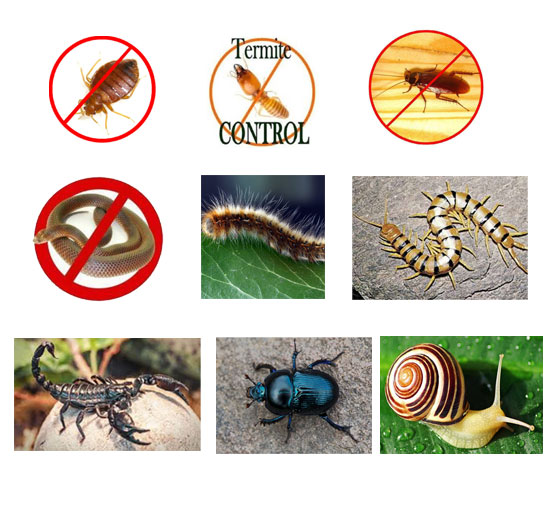Pest Types

Pests can be categorized into different types based on the environment they infest and the damage they cause. Here are the main types of pests:
1. Insects
Ants: Common household pests that can infest kitchens, pantries, and other areas in search of food. Cockroaches: Known for spreading diseases and causing allergies, they prefer dark, moist areas like kitchens and bathrooms.Bed Bugs: These tiny pests feed on human blood and are notorious for infesting mattresses, bedding, and furniture.
Flies: Including house flies, fruit flies, and drain flies, these pests are attracted to food waste, garbage, and organic matter.
Termites: Wood-eating insects that cause extensive damage to wooden structures and furniture. Mosquitoes: These pests are known for biting and can transmit diseases such as malaria, Zika virus, and West Nile virus.
Beetles: This group includes pests like carpet beetles and pantry beetles that damage fabrics and stored food.
2. Rodents
Rats: These pests are known for infesting homes, chewing through wires and insulation, and spreading diseases like leptospirosis and hantavirus.
Mice: Like rats, mice are notorious for causing damage to property and contaminating food with urine and droppings.
Squirrels: Squirrels may enter attics and roofs, causing damage to structures and insulation.
3. Arachnids
Spiders: While most spiders are harmless, some can be venomous (like the black widow or brown recluse) and pose a danger to humans.
Scorpions: Found in warmer climates, scorpions can sting and are dangerous to humans.
Ticks: Ticks can spread diseases like Lyme disease and are often found in wooded or grassy areas.
4. Birds
Pigeons: These birds can cause damage to buildings with their droppings, which can erode stone and metal surfaces over time.
Starlings: Known for their large flocks, they can damage crops and spread diseases.
Crows: These birds can be a nuisance by raiding garbage and spreading disease.
5. Wildlife Pests
Raccoons: Raccoons often enter attics or basements and can cause damage to structures while searching for food.
Opossums: These nocturnal animals may enter homes or attics and cause damage or leave waste behind.
Skunks: Known for their distinctive odor, skunks may dig around in gardens or under homes.
6. Fungi & Mold
Mold: Mold can cause damage to the structural integrity of homes, as well as health problems like respiratory issues and allergies.Mildew: A type of mold that thrives in damp environments, often found in bathrooms and basements.
7. Nematodes & Other Soil Pests
Root-knot nematodes: These microscopic worms attack plant roots, reducing their ability to absorb nutrients and water.
Weevils: These pests are common in gardens, attacking plant roots or fruit.
8. Stored Product Pests
Grain Weevils: These pests infest dry food products, such as grains, flour, and rice, often found in pantries.Moths: Clothes moths and pantry moths damage fabrics, clothes, and food stores.
9. Other Pests
Lice: These parasites are common in schools or areas with close human contact, feeding on human blood.
Fleas: Fleas are most commonly found on pets but can also infest homes and bite humans.
Silverfish: These small, wingless insects thrive in damp environments and feed on books, wallpaper, and fabrics.
